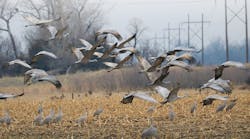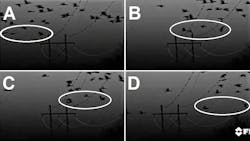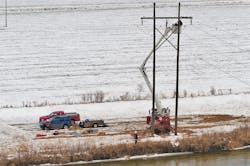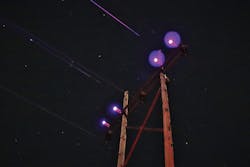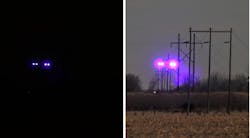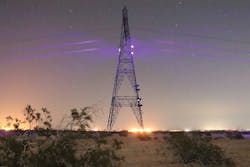For at least the last 30 years, a small percentage of sandhill cranes migrating through Kearney, Nebraska, U.S., have been colliding with a power line crossing the Central Platte River near the Iain Nicolson Audubon Center at Rowe Sanctuary. Within the last few years, the power line has been marked with bird flight diverters and FireFly bird diverters to increase visibility. Even with these two industry-standard practices installed side by side, hundreds of crane collisions still occur each year, nearly all at night.
In addition to not being as effective as desired in this specific application, line markers sometimes are problematic because they can be dangerous and expensive to install, often requiring a helicopter to access transmission overhead shield wires. Line markers also add weight, wind loading and sometimes ice loading to lines, for which design engineers may not have planned. In addition, line markers cannot be installed on some high-voltage transmission conductors because of corona effects. If all that were not enough, line markers sometimes trigger customer complaints because markers make the line too visible.
Electric Power Research Institute (EPRI) teamed up with EDM International Inc. (EDM), the Dawson Public Power District, and the National Audubon Society in Kearney, Nebraska to try to solve all these problems simultaneously with the Avian Collision Avoidance System (ACAS). The ACAS is a patented pole- or tower-mounted illumination system designed and built to shine near-ultraviolet (UV) light — from 380 nm to 395 nm — on power lines to make them more visible to birds at night, without being visible to humans. EDM built the ACAS around four Chanzon 100-W light-emitting diode (LED) chips, powered by a pair of solar panels that can charge six car batteries daily. Dawson Public Power installed the ACAS on an H-frame power pole on Audubon Society property.
The Solution
For most people, visible light goes from about 400 nm (purple) to about 750 nm (red). In people, shorter wavelengths are absorbed by the lens of the eye, preventing damaging UV light from reaching the retinas. Birds’ eyes have a different sort of lens that does not block UV light, so some birds can see wavelengths as short as 325 nm. Not all birds detect the same minimum wavelength, but generally half of avian groups that have been tested to date have been found to be sensitive to UV light, including some species of grouse, loons, owls, pelicans, seabirds, songbirds, storks and waterfowl.
These species are in many collision-prone groups. Other bird species may be sensitive to wavelengths just below that of human vision but have not been thoroughly studied. Overall, perception of UV light by birds can be thought of as birds see more shades of purple than people do. The ACAS explores using the difference in eye physiology between birds and people to mitigate collisions by shining UV light on power lines where bird collisions are known to occur.
To test the concept, an ACAS was installed on the problematic power line span at Rowe. The ACAS then was turned on for randomly assigned nights, illuminating the line with UV light, and turned off for other nights, leaving the line in natural darkness. Crane collisions and near misses were documented with an identical protocol when the ACAS was on and when it was off. These nighttime collisions and near misses were observed and recorded through a military-grade night vision thermal scope with a connected video recorder.
Dramatic Results
During the spring 2018 migration of sandhill cranes, monitoring was conducted on a total of 38 nights, 19 when the ACAS was on and 19 when it was off. When the ACAS was on, one crane collision and 39 near misses were observed. When the ACAS was off, 48 crane collisions, one white pelican collision and 217 near misses were observed. The ACAS reduced sandhill crane collisions with the power line by 98% and near misses by 82%. Cranes foraged normally in fields adjacent to the ACAS when it was on and roosted normally along the river; the ACAS only affected crane behavior immediately adjacent to the power line span, not otherwise. Importantly, unlike physical line markers — which usually are limited on transmission spans to installation on overhead shield wires and optical ground wires — the ACAS illuminated all transmission wires in the span, including the energized phase conductors.
Future Work
The ACAS hit a home run in its first trial, but that does not mean it is appropriate for all birds in all places. Testing in Nebraska was focused on sandhill cranes colliding with wires already marked with two types of line markers, deployed on a line crossing a river and supported by H-frame structures at a key migratory stopover. Whether the ACAS will be as effective in other circumstances remains an open question, particularly because not all birds have the same low-end threshold of light detection.
This question is important to resolve because bird collisions with power lines, cell towers and wind turbines include a diverse array of species, from golden eagles, the second largest bird in North America, to ruby-crowned kinglets, one of the smallest. Across North America, collisions involve a diverse array of bird species and conservation statuses. The best available science focuses largely on water birds, but the wide diversity of species found across studies suggests water birds may be the most easily detected, not necessarily the species at greatest risk in all circumstances. Future work should evaluate the ACAS’s effectiveness in mitigating collisions with species other than sandhill cranes and in mitigating collisions with unmarked lines supported by other types of structures in other habitats.
The effective distance of the ACAS also is unknown. The test span at Rowe was 258 m (846 ft) long. The ACAS was effective over the entire length of that span, but its effectiveness over longer spans needs further study. Might the ACAS be effective over the 500-m (1640-ft) spans seen on canyon crossings and 500-kV lines? This is not known yet. Perhaps the ACAS’s wavelength and directionality will need to be adjusted for long spans, or perhaps it does not need to be quite as bright to be effective on short spans. Only time and additional research will tell.
The effectiveness of the ACAS was studied on an H-frame supported span. Future research also should include a variety of T&D line voltages and configurations. Will the effectiveness differ with different numbers or arrangements of wires, including lattice towers, monopoles, double-circuits and bundled conductors? Guy wires supporting communication towers are another type of suspended wire involved in bird collisions. Could ACAS units be installed to illuminate guy wires from below? If so, the ACAS might much more effectively and efficiently solve collisions with guyed towers and the guy wires themselves than other approaches have to date.
Bird collisions with wind turbines also are a widespread concern for electric utilities investing in renewable portfolios. Can ACAS units be deployed to mitigate bird collisions with turbine blades? Future research should tackle the technical challenges of illuminating pivoting nacelles and rotating turbine blades. To address these unresolved issues, EPRI and EDM are eager to find additional sites where electric utilities have ongoing unresolved bird-collision concerns. This could involve distribution lines and transmission lines, or stepping outside those boxes with guyed cell towers and wind energy projects.
The engineering involved in deploying the ACAS — such as solar power calculations and verifying towers can support the weight — is likely appropriate only in situations where bird collisions are known to be an ongoing problem for very specific spans. In those situations, like the one at Rowe, the ACAS just might be the solution electric utilities need.
Interested in more detailed reporting of the ACAS performance? Read the peer-reviewed scientific article “Near-Ultraviolet Light Reduced Sandhill Crane Collisions with a Power Line by 98%,” published in the May 2019 issue of The Condor: Ornithological Applications by James Dwyer, Arun Pandey, Laura McHale, and Rick Harness.
Acknowledgement
The EPRI Team wishes to thank Laura McHale for conducting the nocturnal observations described here. We thank Gary Haines and his crew at Dawson Public Power for installing the ACAS and Bill Taddicken and Andrew Pierson at the Iain Nicolson Audubon Center at Rowe Sanctuary for their logistics help throughout the study.
For more information:
Dawson Public Power District | www.dawsonpower.com
EDM | www.edmlink.com
EPRI | www.epri.com
Audubon Society | www.audubon.org
